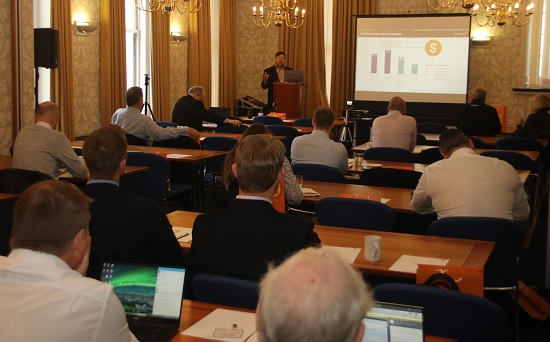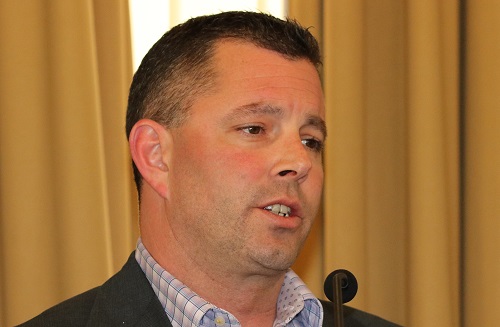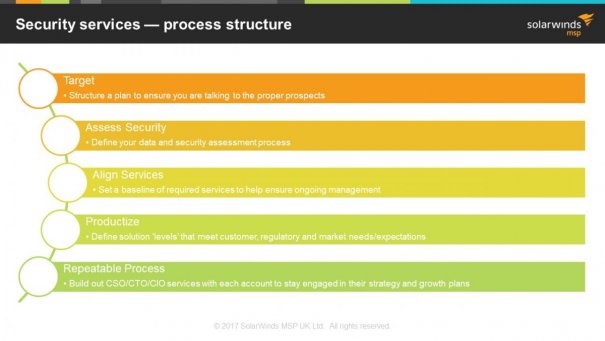SolarWinds MSP seminar for MSPs shows patterns of change and how they can take advantage of market changes
A wave of change will hit the managed service sector in the next period and SolarWind MSP is investing to support MSPs in a period of great change, MSPs at a London meeting were told.
Dave Sobel, Senior Director of Partner Community at SolarWinds MSP said that he was optimistic: “Year after year we are seeing spending growth on IT as our collective customers are spending more; we’ve even seen growth in the off-years. It is projected to have healthy growth for at least the next three years.”

See also his comments on GDPR
But there will be more pressures, he continued: “We’re starting to see more competition in the market and there are some interesting trends. I am looking at the North America statistics but it is consistent across the world. A chart of the percentage of solution providers founded in each year shows that there was a peak around the new millennium – now some 33% of all solution providers were founded 25 years ago or more; one third of the businesses are 25 years old! We have a generation that is about to change - they will sell up or merge.”
And a new wave of entrants will also provide new competition: “Over the last five years we have seen solution providers entering the business. And they look very different from 25 years ago – you would be cloud-first now and focus on implementation and service, and have no backend infrastructure, and would work with customers starting that way and who are moving into the cloud. That is not to say what went before was wrong; it is important for us to think about who we are now fighting in a competitive sense.”
MSPs have to find new ways to differentiate – being in business a long time is not what customers want now, and new technologies will change what is on offer and what customers want. Computing has changed – the computer often now a phone – so it is not the form factor – desktop, server, device - but what it does.
“IT service providers often fall into default thinking of supporting desktops and services/components – but it is more than that. All the top trends have nothing to do with form factors – smart devices, user experience, autonomous agents – this is what tech is about now. As Solution Providers we have to focus on the new environment and the opportunity around that,” he says.
IoT is a being dismissed as a bad term for a nice idea but there are real projects and implementations in the market already and 60% of organisations have some sort of initiative. “It is really interesting in system building – the devices are fine, but the value is in combining them into some kind of system.”
“The providers of the systems will make the most money – the solution providers and MSPs will do best – the ecosystem of IoT is hardware +software, rules and interactions and systems building – that is what we have been doing for a long time. This is important.”
There will be lots of opportunities – information matters more than machines. “So I don’t think about the machine - I think about the data – MSP customers want to know how to get to the data and work with it in better ways. We are on the cusp of new data driven business now that we can tie it all together. Looking at solution providers and data-driven statistics, we see that while 44% of firms say they are data driven, only 8% have data driven processes, even though those that dive into this area are seeing 100% plus returns.
SolarWinds MSP is currently looking seriously at analytics and how to make it work for better outcomes.
“Solution Providers need to know how to drive the enterprise execution via data and there is a huge opportunity for us and to help our customers. I don’t expect SPs to be building data science teams, but we should be leveraging tools and understanding how the tools fit together; it fits nicely into the IoT segment so our message is ‘managing everything’ – you need to get the data you need to drive execution from this.”
Security is the last item but is on everyone’s mind – it is by far the area that is dominating discussion because most people don’t have answers. And there has been an evolution in national thinking – The US now has a cybercrime force alongside its other armed forces; organised criminals have displaced hackers who were once specialised individuals. It is automated and aims to collect incidents as a volume game.
Non-experts tell the customer to use antivirus, adopt strong passwords and make them change passwords often, plus “Only go to sites you know; don’t share personal information”. These are out of line with a proper security positions. Actual experts say “install software updates and keep them updated .... and rermove admin rights from almost everyone".
“You are going to be breached – it is just a matter of time. There are two types of customer: those that have been breached and those who don’t know they been breached. At least the time to discover breaches has fallen - from 240 days to 70 days, but this still means the incident is past-history.” This is the hottest area in the market – clearly the area where customers need answers and SolarWinds MSP is thinking about a ‘Layered approach’ to protection and resolution, he concludes.

David Weeks (above), Senior Global Sales Manager at SolarWinds MSP, says that this layered approach for MSPs means that they can better target and structure the qualified buyers to discover who are the best potential candidates for a sale – and who should be removed as a target! “You have to be prepared to walk away from the business or you end up taking all the risk in an un-managed environment,” he warns.
To do an assessment on security, remember that customers all look at data differently – it could be financials, process or just unstructured information and there will be a back-up system. “This approach should allow you to walk into an environment in a non-intrusive way. You are aiming to get a level of confidence about the risk and deciding whether you can and want to do anything,” he says.
The approach is to say to the customer: “Let me be a third party – it is a great way to displace a supplier, by the way - do an assessment and report back”. Security has four areas: infrastructure, data, risk management and identity, within these there are a lot of services such as aspects of end-point authorisation – it all depends on the customer and what level the service provider wants to go to.
“Most businesses believe that everything is taken care of – but the assessment shows vulnerability – so we have to take the business across this chasm.” Do the security assessment and award a pass/fail or conditional which defines the level of service. The first layer is protection, then detection – see what you are missing, then comes analyse and manage as a true back-up. Recovery- the final level- is getting towards advanced cyber security.
“By assessing the risk in this way you decide whether to take on the business and make the investment. You have to say: ‘These are the minimum standards before we take you on’ – you need to have the confidence to walk away – if you let the customer regulate it you get all the liability and it is a quick game to zero.”

“Anyone on your security programme must adhere to it.” They need to understand what they can do and how because of the level of risk. And they must use only your products where your engineers have been trained and are experts on the small subset of the large number of products out there.
“It needs to be repeatable business; you are in it for the long term; entrench yourself in their business so that you become part of their processes,” he concludes.
Francesco Dibartolo, Head of MSP Distribution Sales EMEA at SolarWinds MSP looked at the scale of requirements that customers are looking for. At the basic level, clients want to use “best of breed tools to solve everyday IT problems, with simple, fast, reliable and easy to use products and cost effective technology”. So that is the base line; growing managed services businesses want to consolidate tools to increase efficiency & profits as contracts move from a reactive to a proactive model. In this way a recurring revenue is created, and it becomes more profitable for the MSP, he said.
Finally, mature managed services businesses are looking to: automate processes to maximise profits, eliminating risk and cost through Monitoring, Automation and Security. With this in mind, he highlighted the ability to find vulnerable data with SolarWinds MSP Risk Intelligence, a SaaS platform with a cost-based risk assessment, sensitive data discovery, OS & Application vulnerability scanning, delivering risk trending reports showing value and Inappropriate access visibility.